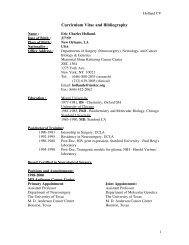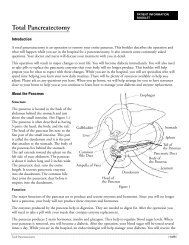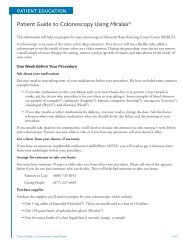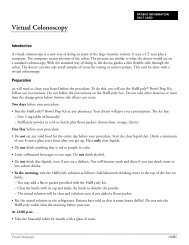Caring for Your Biliary Drainage Catheter - Memorial Sloan ...
Caring for Your Biliary Drainage Catheter - Memorial Sloan ...
Caring for Your Biliary Drainage Catheter - Memorial Sloan ...
You also want an ePaper? Increase the reach of your titles
YUMPU automatically turns print PDFs into web optimized ePapers that Google loves.
Inspecting <strong>Your</strong> <strong>Catheter</strong><br />
Inspect your catheter every day. Use a hand held mirror or a full length mirror or both.<br />
1. Look at the position of the black mark. Make sure it is near the disk. (Figure 4) <strong>Your</strong> nurse will show you what<br />
to look <strong>for</strong> be<strong>for</strong>e you leave the hospital.<br />
2. Check the dressing to assure that it is secure. If the dressing is wet, soiled, has come loose or started to lift from<br />
the skin, it needs to be changed.<br />
3. Examine the skin around the catheter to see that it is in good condition. There should be no redness, areas of<br />
broken skin, or rash. Fluid should not leak around the catheter.<br />
4. Look at the fluid in the bag. It should be flowing freely into the bag. It should not have changed color or consistency.<br />
5. Inspect the catheter and the drainage bag <strong>for</strong> kinks in the tubing.<br />
If you find a problem, call the interventional radiology nurse<br />
practitioner or fellow. The phone numbers are listed at the end of this booklet.<br />
Instilling Sterile Normal Saline into the <strong>Drainage</strong> <strong>Catheter</strong><br />
You will need to flush your catheter with 10ml of normal saline twice a day. To do this you will need:<br />
• A 10ml pre-filled normal saline syringe.<br />
• 2 alcohol wipes.<br />
1. Wash and dry your hands be<strong>for</strong>e you begin.<br />
2. Remove the cap from the syringe with a twisting motion. Lay the syringe on the table. Do not allow the tip of<br />
the syringe to touch anything.<br />
3. Sit or lie com<strong>for</strong>tably. The “off” tap of the stopcock should be facing the Clave. Turn it in the direction of the<br />
drainage bag. (Figure 5)<br />
4. Rub the blue Clave thoroughly with an alcohol wipe. Attach the syringe onto the Clave using a clockwise<br />
motion. Push the plunger of the syringe. Instill the saline in short bursts of two to three ml of fluid at a time<br />
until you have instilled 10 ml total. Never pull the plunger back after pushing the saline through the catheter.<br />
5. Stop the instillation if you:<br />
– Have pain.<br />
– Feel resistance.<br />
– See leaking around the catheter.<br />
Call the nurse practitioner or doctor at the numbers listed at the end of this booklet.<br />
6. Remove the syringe with a twisting motion and discard it.<br />
7. Turn the “off” tap of the stopcock back in the direction of the Clave. (Figure 5)<br />
8. You should see fluid drain into the bag.<br />
Changing the Uresil ® dressing<br />
The Uresil dressing system is designed to help keep the catheter from moving out of the bile ducts. The disk is<br />
secured to the drainage catheter. The dressing covers the disk, which helps to keep the catheter in place.<br />
<strong>Caring</strong> <strong>for</strong> <strong>Your</strong> <strong>Biliary</strong> <strong>Drainage</strong> <strong>Catheter</strong> [ 5 of 11 ]

















